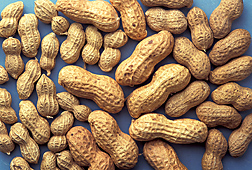USA
July 24, 2017

Photo by Jack Dykinga
A sensor network developed by Agricultural Research Service (ARS) engineers could make it easier and cheaper for peanut growers and processors to dry their peanuts.
In Georgia, farmers bring their peanuts to a buying point for grading and pricing. If the moisture content is too high, the semitrailer loaded with peanuts is transferred to a drying bay for a drying process that might takes days. About once every four hours, someone also has to climb up into the semitrailer, collect peanut samples, shell them and measure their moisture content.
If the peanuts are under-dried, over-dried or dried too slowly or quickly, it degrades their quality, and they will sell for a lower price, according to Samir Trabelsi, an ARS electronics engineer in Athens, Georgia.
Trabelsi and ARS agricultural engineer Micah Lewis designed a sensor network that monitors temperatures and humidity levels inside the semitrailers and the kernel moisture content. A weather station also tracks outdoor air temperatures, humidity levels and wind speed—which all can affect the peanut drying rate.
Trabelsi and Lewis recently upgraded the technology to provide real-time moisture readings to a computer or smart phone. That way, when peanuts are sufficiently dried, operators can turn off the drying blowers, and no one has to climb up into semitrailers to collect peanuts and check their moisture content.
The researchers also showed in a recent study that the real-time monitoring capability could save more than $20,000 a year in energy costs at a typical drying station. The savings are significant, considering Georgia has 130 peanut buying points. Peanut growers pay to use the privately owned stations, so the technology should lower the fees for growers, Trabelsi notes.
Results were published in Drying Technology: An International Journal.
You can read more about this research in the July 2017 issue of AgResearch magazine.
For more information contact Dennis O'Brien, ARS Office of Communications.
The Agricultural Research Service is the U.S. Department of Agriculture's chief scientific in-house research agency. Daily, ARS focuses on solutions to agricultural problems affecting America. Each dollar invested in agricultural research results in $17 of economic impact.